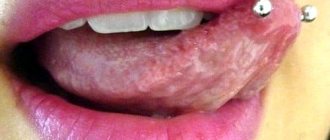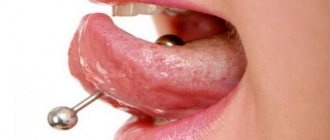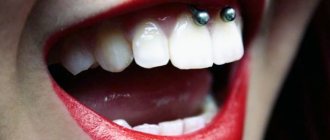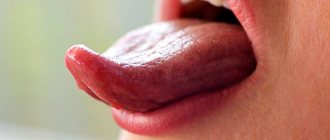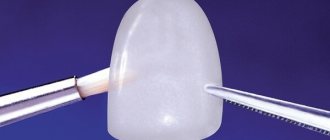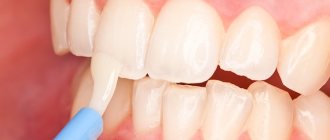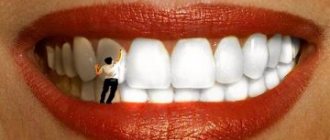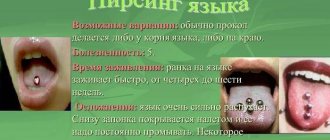Piercing is a fairly common procedure. She no longer causes strong bewilderment and ugly thoughts among those around her. But people still have disputes and misconceptions when they hear about piercing of the nipples or genitals, as well as the tongue. Many people do tongue piercing these days. The reasons for this are varied. But before you make an important decision and come to a specialist to pierce your tongue, you need to determine whether this operation is necessary and whether it has contraindications.
The history of piercing
For the first time, residents of African tribes and Polynesia began to practice the procedure of piercing various parts of the body. The Maasai were the first to introduce various decorations into their ears and lips. At that time, it was believed that the larger the size of the jewelry in the body, the greater the “weight” a person had in the tribe.
Navel piercing first appeared in Egypt. Women loved this procedure very much. The presence of a hole in the navel area of the Egyptian woman indicated that she belonged to “high society.”
In Tsarist Russia, sailors preferred to pierce their earlobes and wear voluminous earrings. Such a “symbol” meant that the person crossed the equator or belonged to the Cossack family. Later, starting in the 80s, it became fashionable for rappers to pierce their earlobes.
Nose piercing first appeared in India. The presence of a septum piercing (a puncture of the nasal septum) in a woman indicated her marital status, that is, that the girl was married.
Nipple piercings were done by warriors of Ancient Rome. An earring in a man's nipple indicated his masculinity, courage and determination. Only the strongest and bravest warriors had the right to have nipple piercings. Those with nipple earrings regularly competed in strength and courage. In order not to damage the “decoration”, special fabric capes were worn over the earrings.
The ancient Aztecs and North American tribes first began piercing their tongues. They carried out the procedure consciously, since it was considered a magical rite that helped to reunite with the Gods. The protruding blood on the tongue was considered sacred; it served as a means of calming the Spirits.
These days, piercings have completely different purposes. By piercing various parts of the body, people want to show their individuality, attract attention or stand out. For some, piercing is a way to feel new emotions, to prove to themselves that they can overcome pain and, as it were, move to a “new level of development.”
Star tongue piercing
In the new Western culture, tongue piercing began to gain high popularity in the 1990s. Melanie Brown, a singer from the Spice Girls, became one of the first stars, thanks to whom tongue piercing began to actively spread to the masses.
Keith Flint, the lead singer of the Prodigy group, also pierced his tongue. Will Smith's daughter got a piercing at the age of 14, although some media outlets wrote that the jewelry may not be real and is attached with ordinary magnets. A few years later, the young vocalist proved that the barbell was real.
Drew Barrymore, a famous Hollywood star, pierced her own tongue immediately after breaking up with her husband Justin Long. According to numerous media outlets, as well as close friends, she took such a step only in order to attract additional attention from new fans. The actress said that wearing jewelry on the tongue is an excellent diet during the wound healing period.
Before deciding whether to undergo a tongue piercing procedure or not, it is necessary to consider with utmost importance the available contraindications, advantages and disadvantages of the piercing. It is especially important to choose the right material, shape, and size of the barbell to be worn. Such simple rules can significantly reduce the likelihood of infectious infection or any other dangerous processes.
Tongue piercing procedure
Tongue piercing is a surgical procedure. Although it is short-lived, it can be very dangerous to health, and in certain cases, to life. The procedure is a sharp puncture of the soft mucous membrane of the tongue with the further introduction of a special earring or barbell.
Among the huge variety of “decorations”, the most common are vertical rods cast from medical titanium or steel. In appearance, the earring turns out to be double, that is, it can be seen both from above and, if you lift your tongue, from below.
Another popular type of piercing is the frenulum. This procedure for introducing a frenulum into the tongue is less painless; during the operation, the client releases less blood, and, accordingly, healing of the wound surface occurs much faster.
Other "decorations":
- rings;
- carnations;
- staples.
Choosing jewelry for girls (women), men
Before the procedure, the piercer will help you choose jewelry if the client has not purchased it in advance. If you want to buy it yourself, then a few tips below will help you make the right choice.
It is worth noting that there is no clear division between women's and men's jewelry. But unwritten rules still exist:
- Men's jewelry is distinguished by a clear geometric pattern (broken lines, checkered patterns), while women's jewelry is distinguished by a smooth transition of lines and a rounded shape.
- Men's jewelry is massive, while women's jewelry is graceful and miniature.
- Men's jewelry is characterized by laconicism - their design often uses dark or light muted matte colors. Women's, on the contrary, are distinguished by a variety of shapes, colors and inlay with different stones, ranging from simple rhinestones to diamonds.
Purpose of piercing
People who decide to have their tongue pierced have different goals. It is widely believed that the presence of an earring in the soft tissue of the tongue improves sexual satisfaction in a partner. Young girls often decide to have their tongue pierced simply to become fashionable. Some people pierce a part of their body in order to show others that they belong to a certain subculture.
Tongue piercing helps people stand out “among the crowd,” to indicate that they are not like everyone else, and to prove their own uniqueness and individuality.
Advantages and disadvantages
The presence of an earring in a person's tongue always attracts everyone's attention to him. The corresponding procedure can be treated both poorly and well. But almost always the presence of a puncture arouses interest among others.
Anyone who agrees to have their tongue pierced feels special, different from everyone else. In this way a person wants to show his individuality. And some people decide to get piercings in order to show their decisive character or, conversely, to overcome themselves.
Pros of a puncture
- After the procedure, a person begins to consider himself liberated, courage and determination appear in his character. Anyone who decides to have their tongue pierced “challenges” a monotonous and boring life.
- Tongue piercing is not as noticeable to others as, for example, eyebrow piercing. If necessary, the “decoration” can be removed, and no one will notice the presence of a puncture.
- Improves sexual sensations for a partner. When kissing or performing oral sex, tongue piercing can add additional sexual arousal and add a sense of exoticism to sexual contact.
- After surgery, a long recovery period is required. At this point, you need to follow a strict diet and give up a large list of foods. This restriction helps some people lose weight.
- If all the basics of proper care are followed, the risk of complications is minimal.
- The ability to remove the “decoration” at any time and ensure that the tongue piercing is healed. Thanks to active regeneration of soft tissues, the puncture heals very quickly.
Flaws
- The procedure is very painful. If a person is very sensitive to pain, then it will be difficult for him to undergo such an operation.
- The recovery period, which can “stretch” for several months, also brings a lot of inconvenience. The healing process of the wound surface provokes pain and physical discomfort. It can take from 3 to 6 months before all the unpleasant sensations end.
- Piercing needs to be done only in a specialized clinic or salon, and always by an experienced and qualified master. Many people pierce various parts of the body at home. But in this option, the risk of developing dangerous complications increases sharply. Saving on your own health can cost much more than the cost of surgery in a trusted clinic.
- There is a risk of infection. This often occurs due to the use of unsterile instruments during surgery. The development of infection is not the worst complication of piercing. Complications include hepatitis and herpes. The likelihood of developing complications dangerous to health increases significantly if the procedure is performed by inexperienced or unqualified professionals.
- Tongue piercing almost always damages teeth. This occurs due to the fact that a person has a desire to “chew” or bite the earring. Teeth begin to deteriorate and break for another reason - while chewing food, an unintentional biting of a metal rod occurs.
- If you have a tongue piercing, careful care of your teeth and gums is required. Many young girls and boys, in order to boast about the presence of “decoration” in their mouth, show it off to others who touch the barbell with their hands. All this causes an increase in the number of bacteria and pathogenic microorganisms in the oral cavity.
- Development of gum disease.
- The presence of a foreign body in the oral cavity often provokes the development of discomfort - redness of the mucous membrane, itching, the desire to scratch the tongue.
Dissolve ice or apply a cold compress / Cold compress
Cold compresses reduce pain and swelling. Numbness may be preferable to warm compresses, especially if you are experiencing severe pain.
Ice
You can suck on ice cubes for a few minutes to relieve symptoms. Repeat as many times as you want for body and face.
Regular compress
If ice cubes are not your thing, you can use a bag of frozen vegetables or soft ice to find relief.
To use a cold compress:
- Wrap the compress in a thin or strong paper towel.
- Gently apply to affected area for up to five minutes at a time.
- Repeat twice a day.
- Apply a warm compress | Warm compress
A warm compress can also minimize overall swelling and irritation.
You may not want to use a warm compress if you are already experiencing uncomfortably warm temperatures at the piercing site. In this case, start with a cold compress and progress to a warm compress if necessary.
Regular compress
You can make your own warm compress by placing a damp towel or other cloth-based item in the microwave for 30 seconds at a time.
Some store-bought compresses contain herbs or grains of rice, which help retain heat and apply gentle pressure. Beauty salon tattoo body and face enlarge individual parts.
You can make these changes to your homemade compress as well. Just make sure the fabric can be sealed or folded so that none of the added ingredients fall out.
To use a warm compress:
- Place a damp cloth, sock, or other homemade compress in the microwave for 30 seconds. Repeat until it is comfortably warm to the touch.
- If you have a heat compress, microwave or over-the-counter heat as directed on the product package.
- Apply the compress to the affected area (tattoo) for up to 10 minutes, up to two times a day.
Chamomile compress
Chamomile as a source has antioxidant and anti-inflammatory properties. A warm chamomile compress can speed up the healing process.
First, do a patch test to make sure you are not allergic to chamomile. Do it:
- Steep a chamomile tea bag in warm water for two to three minutes.
- Place the tea bag on the inside of your elbow.
- Leave on for three minutes and then remove. Let skin dry without rinsing.
- Wait 24 hours. If you do not experience redness or other signs of irritation, it is safe to apply a chamomile compress to the piercing.
To use a chamomile compress:
- Immerse two chamomile tea bags in boiled water for five minutes.
- Remove the tea bags and let them cool for about 30 seconds. The bags should be warm to the touch.
- Wrap each tea bag in a cloth or paper towel. This will help prevent the fibers from getting caught on your jewelry.
- Place a tea bag on each side of the hole for 10 minutes.
- Refresh tea bags with warm water if necessary.
- After 10 minutes, rinse the affected area with warm water and pat dry gently with a clean paper towel.
- Repeat this process daily.
- Avoid over-the-counter antibiotics and creams.
Over-the-counter antibiotics have long been used to treat infections. However, they are useless - and may even be dangerous - for body and facial piercings at a beauty salon.
Topical creams and ointments can trap bacteria inside the piercing and make the situation worse. Additionally, they are not intended for use in the mouth.
Oral cleansers containing hydrogen peroxide, alcohol and other antibacterial ingredients. They can also damage healthy skin cells and slow down the healing process.
You'd better stick to the cleansing and compress routine. Contact your piercer if you don't notice improvement within a day or two. Tongue piercing beauty salon tattoos to enlarge individual parts of the body and face.
The degree of pain of the procedure
Any operation is painful. And tongue piercing is no exception. The puncture procedure itself lasts a couple of seconds. The patient feels a sharp, but quite tolerable pain. The main painful sensations begin at the stage of healing of the wound surface. The lining of the tongue is highly sensitive, and since this organ of the body is constantly moving, the pain will be excruciating. The discomfort will continue until the wound heals.
It is possible to reduce the intensity of painful sensations. To do this, you must adhere to the following basics:
- The operation should only be performed in a specialized clinic (salon) by a qualified specialist;
- During the recovery period, constantly care for the wound;
- stop smoking and drinking alcoholic beverages (at least for the recovery period);
- try to talk less in the first days after surgery;
- Avoid eating hot and spicy foods.
Care instructions
Immediately after the procedure, at least for one day, you should give up solid foods and spicy dishes, as well as seasonings with strong specific tastes. Special care during this period involves regular rinsing with the use of pharmaceutical antiseptics and medicinal herbs - before this it is better to consult a doctor. It is also worth changing your toothbrush and then rinsing it thoroughly after each brushing. During daily hygiene procedures, you should thoroughly rinse your mouth, including under the tongue, but this should be done carefully, trying not to strain the organ too much.
It is important to follow all recommendations after the procedure so as not to encounter complications.
If you recently got your tongue pierced, take care of it while it heals. There is nothing complicated about it, but there are a number of restrictions that should be adhered to. Try to eat warm foods, not too cold or hot, and minimize any risk of accidental injury to oral tissue. Taking good care of your health will help prevent a lot of serious problems.
- According to the legislation of the Russian Federation.
Puncture procedure
Tongue piercing is an operation. To avoid complications, it is recommended to carry it out in a specialized salon. Only a qualified doctor can perform the procedure properly. Only a master can determine the optimal place for a puncture, where the risk of injury to nerves and blood vessels will be minimal.
During the operation, sterile instruments and disposable rubber gloves must be used.
Sequencing:
- The oral cavity is treated with an antiseptic. In most cases, patients ask for additional oral anesthesia. Lidocaine solution is used as an anesthetic.
- A special clamp is used to fix the tongue.
- A puncture is made on the tongue fixed with a clamp. The direction of the needle is from bottom to top.
- A metal rod or a “decoration” chosen by the patient is inserted into the resulting hole.
Tongue piercing at home
It is not advisable to do piercing yourself.
To minimize the risk of complications, the following requirements must be met:
- A well-lit place is selected for the operation. There must be a table in the room on which the necessary tools are laid out.
- For the operation, only sterile instruments (clamp, needle, earring) are used.
- The oral cavity must be treated with a disinfectant solution and, if necessary, irrigated with an anesthetic drug.
- For the puncture site, select the part of the tongue located closer to the tip. There are no large blood vessels in this area of the organ.
- The tongue is clamped with forceps.
- A special needle pierces the soft tissue of the organ strictly perpendicular to the surface.
- The bar is threaded. It is recommended to use a catheter to insert the “decoration”.
A catheter is a special device that helps you do piercing at home. Thanks to the catheter, the sensation when piercing the soft tissue of the tongue is less painful.
The catheter is a small needle equipped with a plastic tube. An earring or other “decoration” is inserted into the cavity of the tube. After the puncture, the earring goes into the hole along with the needle. Subsequently, the needle and catheter are removed, and the “decoration” remains in the inner part of the tongue.
How is tongue piercing done?
Tongue barbell piercing (it is better to choose a product based on individual characteristics and preferences), despite the established opinion, is still considered a surgical intervention. The operation should be carried out exclusively in a professional and qualified salon.
Step-by-step algorithm for tongue piercing:
- Fixation of the position of the tongue using a special clamp, which is characterized by the presence of a hole for a future puncture.
- Piercing the tongue using a special needle in a clamp. Since it is important that the needle is as sterile as possible, it is better to use disposable instruments. This will reduce the chance of infection.
- Inserting the rod into the resulting hole using a tool.
- Removing the clamp and needle.
Since the procedure does not require much time, it can be performed without the use of an anesthetic . If the patient has a low pain threshold or is afraid of blood, painkillers may be used.
After the procedure, the person must rinse the mouth using a special disinfection solution. The most commonly used substance is “Chlorhexidine”, which is diluted with water in a ratio of 1:4.
To ensure that the puncture is even, the master can use special markings. It is important that the future piercing site is located strictly in the center of the tongue. Placing the jewelry close to the root causes severe chafing and discomfort.
Recovery period
The most painful and unpleasant sensations occur during the recovery period. Until the wound surface heals, a person must observe strict restrictions.
On the first day after surgery, the surface of the tongue is very sore and swollen. These changes are normal, pain is the result of soft tissue trauma, and swelling is the cause of damage to lymph flows and blood vessels. The swelling may last for several days.
The wound heals within 2-3 weeks. Complete healing of the wound surface occurs 3-4 months after surgery.
During the first weeks after surgery, you should be careful about your diet. It is important to exclude all spicy, smoked, salty foods from the menu. Dishes should not be hot. It is optimal to eat liquid, fresh, warm food.
Caring for a pierced tongue
The basis of tongue piercing care is the treatment of soft tissues. Every day, twice a day, the wound needs to be treated with antiseptic solutions (Chlorhexidine, a solution of baking soda or potassium permanganate).
For the first 2 weeks after surgery, you need to rinse your mouth after eating. The first days, rinsing is carried out with antiseptic solutions (Chlorhexidine). In the future, you can rinse your mouth with decoctions of medicinal herbs (chamomile, sage, calendula).
Barbell care
For 2 weeks after the tongue piercing, you need to clean the barbell daily with a toothbrush. After this time, it is necessary to regularly remove the “decoration”, thoroughly clean it of surface contaminants and disinfect it in a Chlorhexidine solution.
How long does it take for a piercing to heal?
For many who have already decided to decorate their tongue with a spectacular earring, the question remains open of how long it takes for the organ to heal after piercing. As a rule, the whole process lasts from 5 days to 2 weeks - much depends on the characteristics of the body.
Regarding how long the healing process takes, we figured it out. It remains to find out how long the tongue can hurt after a puncture. Unpleasant sensations and discomfort usually persist throughout the healing period. At first, a swollen organ may make it difficult to speak normally. Here it is extremely important to strictly follow all the instructions of the specialist who performed the puncture. Only if these conditions are met will the wound heal successfully within 10-14 days.
Possible complications
If the operation was performed poorly, the tongue will be very sore after the piercing. Signs of an inflammatory process (redness, severe swelling, itching) will begin to develop on the surface of the soft tissues. Healing of the wound surface will occur slowly.
Complications after piercing:
- heavy bleeding;
- infection of the wound surface;
- pain while eating, swallowing or communicating.
If negative consequences develop, an emergency visit to the doctor is necessary. Treatment of the inflammatory process consists of treating the wound surface with antibacterial and anti-inflammatory solutions. Your doctor may also prescribe antibacterial injections.
Contraindications
Piercing is quite popular these days. But tongue piercing is not available to everyone. Before you decide to have surgery and go to the specialist, you need to study the list of contraindications:
- allergy to antibiotics;
- pregnancy period (the risk of infection poses a serious threat to the expectant mother and baby);
- allergy to metals;
- diseases of the nervous system;
- poor blood clotting;
- oral diseases;
- epilepsy;
- some autoimmune diseases (diabetes mellitus, hemophilia).
Tongue piercing is a modern procedure that helps a person stand out among the “crowd.” But before you decide to have a puncture, you need to evaluate all the disadvantages, consequences and dangers of a difficult operation.
Sources used:
- Harden, Blaine. Coming to Grips With the Enduring Appeal of Body Piercing, The New York Times
- A. Stirn (2003): Body piercing: medical consequences and psychological motivations., The Lancet
- Wikipedia material
